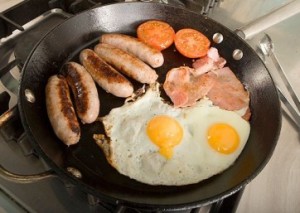Ketogenic diet ever popular
A ketogenic diet has become very popular with body builders and/or those wanting to lose weight. This diet allows one to lose fat weight without losing muscle mass, and in fact, while gaining muscle mass in the case of some body builders.
A ketogenic diet, also referred to as a ketosis diet or a keto diet, forces the body to burn fat as its primary energy source instead of carbohydrates. This is done by forcing the body into a metabolic state called ketosis, hence the name “ketogenic diet” or “ketosis diet.” Ketosis is considered a safe and healthy metabolic state and should not to be confused with ketoacidosis, a dangerous medical condition.

The state of ketosis is reached by very significantly lowering the intake of carbohydrates in the diet while at the same type significantly increasing the fat intake and making sure to eat adequate amounts of protein to maintain muscle. When carbohydrates are eaten, the body will preferentially burn these, not fat, for energy. However, if one stops eating carbohydrates or eats them in very low quantity, the body is forced to turn to stored fat for energy. The body will burn the fat stored in the liver first, and then when this is used up, it will burn fatty adipose tissue, commonly referred to simply as fat. An example of fatty adipose tissue would be the fat stored in “love handles” or “fatty thighs.” It is not uncommon for an overweight person to lose 5-6 pounds a week while in ketosis.
ketogenic diet limited carbohydreates
Normally when someone eats carbohydrates, these carbohydrates are first broken down into glucose. This glucose then raises the blood sugar and triggers the pancreas to produce the hormone insulin. This insulin then helps the body break glucose down and use it for fuel. However, if carbohydrates are significantly limited, a hormone called glucagon is produced by the pacreas and this forces the body to use a secondary metabolic pathway for energy. Glucagon stimulates the liver to convert fat into fatty acids and ketone bodies, also called ketones. These ketones can be used instead of glucose to fuel the brain and other organs.
The ratio of macronutrients in a strict ketogenic diet is around 65 percent fat, 30 percent protein, and five percent carbohydrate. Keep in mind though that these ratios can vary considerably depending on the exact type of ketogenic diet one follows. Typically the diet consists of a lot of meat, seafood, eggs, cheeses, butter, and vegetables very low in carbohydrate and very high fiber such as kale, mustard greens, broccoli, and celery. One can basically eat all of these foods they want because they are very filling and contain little to no carbohydrate.
Some ketogenic diets will also include reasonable portions of foods like cucumbers, peppers, nuts, avocados, sweet potatoes, squash, whole wheat pasta, and quinoa. These foods are a little higher in carbohydrates so portion size is watched closely and generally kept small. However, all forms of sugar and white starchy foods are strictly off limits. These include white bread, white potatoes, most pastas, pancakes, fruit juice, tortillas, and corn. It is usually recommended that one also take a high quality multi-vitamin and a calcium supplement to make up for a lower intake of vegetables. However, eating a lot of green leafy vegetables and reasonable portions of other low carbohydrate vegetables can mitigate this potential problem.
Variations of The Ketogenic Diet
While the information above covers the basics of how a ketogenic diet works, there are many different variations of this diet. One of the most popular with body builders is the cyclical ketogenic diet, often abbreviated as a CKD. This variation of the ketogenic diet takes into account the fact that a diet low in carbohydrates does not give high enough bursts of energy needed for high intensity training. For this reason, body builders will sometimes alternate the basic ketogenic diet with periods where they eat higher levels of carbohydrate. They train hard while eating the diet higher in carbohydrates and relax the training while cutting their carbohydrates. A related variation of the ketogenic diet is called the standard ketogenic diet, often abbreviated as a SKD, where a body builder times his or her consumption of carbohydrates precisely around their work-out schedule.
Another popular variation of the ketogenic diet is the MCT diet. MCT stands for medium-chain triglycerides. While most fatty foods, like pure cream and butter, contain long-chain triglycerides, some fatty foods, like coconut oil, contain medium-chain triglycerides. Research has shown that medium-chain fats are more easily and efficiently converted to ketones than long-chain fats. Therefore, if more of the dietary fat comes from medium-chain fats, the overall fat percentage can be lowered a bit and the carbohydrate percentage can be raised a bit and the diet will still have the same effect, i.e. it will still force the body to burn stored fat.
Now that you understand the basics of a ketogenic diet, you can begin to put it into action to lose fat pounds without sacrificing muscle mass.
To read others experiences with the ketogenic diet and bodybuilding ketosis please visit the iron den forum at https://www.theironden.com/forum/
Mike Shiles is a bodybuilder, gym owner, freelance writer, success coach and author of “Burn fat build muscle. He has written thousands of articles on exercise, nutrition and health.